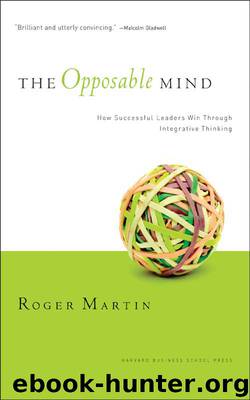The Opposable Mind by Roger L Martin

Author:Roger L Martin [Martin, Roger L]
Language: eng
Format: epub
ISBN: 9781422148105
Publisher: Harvard Business Review Press
Published: 2009-07-06T22:00:00+00:00
The Dynamics of Your Personal Knowledge System
Personal knowledge develops as a system because its three elements influence one another. Stance guides tool acquisition, which in turn, guides experience accumulation.
The flow, however, is not one-way. Experiences inform the acquisition of more tools. Some tools are shortcuts, where we apply experiential learning to pare away excess effort. In the course of performing the same task ten times, you’ll figure out what steps are essential and which can be cut back or eliminated, and what sequence of steps will produce the desired outcome most quickly and reliably.
But developing or acquiring new tools isn’t just a matter of refining a known process. Experience might also guide you to seek new tools from an outside source, and in the process learn a new process, which will then in turn be refined with practice. Perhaps as you work in the lower ranks of an engineering firm, you conclude that your undergraduate engineering degree hasn’t prepared you to take on the work that most interests you. So you decide to return to school and pursue a master’s in engineering, or perhaps an MBA, if the work that most interests you is management or product development.
Young’s experience guided him to further deepen his pattern-recognition skills. When I asked him why the top-heavy IQs had so much trouble formulating a profitable business strategy, Young said the answer was “really straightforward. It’s all pattern recognition, and they had no experience. They had no patterns to compare” their proposed strategy with known business results. His own capacity for making sound strategic decisions, he said, was largely a function of pattern recognition—which by definition requires experience. “It is all pattern recognition,” he says, “and I’ve been around for several rounds.”
As experience leads us to acquire new tools, we add depth and clarity to our stance. If our engineer enters business school and acquires the tools of an MBA, she modifies her view of her place in the world—her stance. No longer simply an engineer capable of tackling the technical aspects of a particular class of problems, she is an engineer with the business skills to view a wider range of problems with a broader perspective and address them with more diverse set of tools.
For Young, pattern recognition became the tool that was central to his stance—he was a sales guy whose experience enabled him to solve problems by recognizing their characteristic patterns. Thanks to his experiences, he grew more and more confident that he could see what was likely to transpire and to make bold decisions on the basis of the patterns he recognized—including the decision to give away Red Hat software over the Internet.
The dynamics of your personal knowledge system are graphically rendered in figure 5-1. Stance guides the acquisition of tools, and stance and tools shape experiences, which in turn inform tools, which in turn inform stance.
The circular relationship between stance and tools was famously noted by communications theorist and philosopher Marshall McLuhan, who in turn was paraphrasing an observation made by Sir Winston Churchill.
Download
This site does not store any files on its server. We only index and link to content provided by other sites. Please contact the content providers to delete copyright contents if any and email us, we'll remove relevant links or contents immediately.
| Bookkeeping | Business Mathematics |
| Business Writing | Communications |
| Decision Making | Negotiating |
| Project Management | Running Meetings & Presentations |
| Secretarial Aids & Training | Time Management |
| Training |
Nudge - Improving Decisions about Health, Wealth, and Happiness by Thaler Sunstein(7471)
Deep Work by Cal Newport(6828)
Principles: Life and Work by Ray Dalio(6141)
Factfulness: Ten Reasons We're Wrong About the World – and Why Things Are Better Than You Think by Hans Rosling(4635)
The Doodle Revolution by Sunni Brown(4625)
Eat That Frog! by Brian Tracy(4392)
Thinking in Bets by Annie Duke(4127)
Hyperfocus by Chris Bailey(4014)
Visual Intelligence by Amy E. Herman(3698)
Writing Your Dissertation in Fifteen Minutes a Day by Joan Bolker(3651)
How to Win Friends and Influence People in the Digital Age by Dale Carnegie & Associates(3472)
Ogilvy on Advertising by David Ogilvy(3464)
Hidden Persuasion: 33 psychological influence techniques in advertising by Marc Andrews & Matthijs van Leeuwen & Rick van Baaren(3421)
How to win friends and influence people by Dale Carnegie(3357)
The Pixar Touch by David A. Price(3336)
Schaum's Quick Guide to Writing Great Short Stories by Margaret Lucke(3286)
Deep Work: Rules for Focused Success in a Distracted World by Cal Newport(3073)
Work Clean by Dan Charnas(3013)
The Slow Fix: Solve Problems, Work Smarter, and Live Better In a World Addicted to Speed by Carl Honore(2918)
